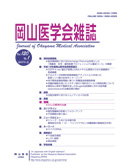

Journal of Okayama Medical Association
Published by Okayama Medical Association<Availability>
Full-text articles are available 3 years after publication.
Permalink : https://ousar.lib.okayama-u.ac.jp/42869
Studies on the "Umayado Disease" Particularly, serological studies on the inhabitants in its's prevailing area
Miyazawa, Kenji
Published Date
1955-12-31
Abstract
The Weil-Felix reaction test performed on the blood sera of healthy persons in Aioi village which had been affected with “Umayado-Disease” and 51 other cities, towns and villages in Kagawa Prefecture revealed as follows: 1) The aggultination titer against the OXK strain on the blood sera of healthy persons in Aioi village is remarkably higher as compared with that in other areas in Kagawa prefecture. This fact shows that the inhabitants of Aioi village are constantly exposed to a danger of the infection of this disease. 2) The strength of the OXK reaction observed in Aioi village seems to be varied according to lacalities; i.e., it is higher at the localities nearer the mountaineous area. In other words, the possible extent of this disease's infection is inversely propotional to the geological elevation of land. 3) My observation on the amount of the antigen produced against the OXK strain shows that the possible extent of the infection of this disease is expecially remarkable at Umayado and Sakamoto. 4) The antigen titer against the OXK strain in healthy persons in Aioi village always changes according to the seasons of the year. For instance, it is constantly higher in autumn, and in spring it drops lower. In view of this fact, it is possibly understood that this disease prevails chiefly in summer-time. 5) With the people in Kagawa prefecture as a whole, the strength of the OX19 reaction becomes higher among the people westward, and lower eastward. This is in coincidence with the conditions of the prevalence of fleck fever in this prefecture. 6) The strength of the OXK reaction, with the people of Kagawa prefecture as a whole, is higher in the easten part of the prefecture, including Aioi village, and in the western part the antigen against the OXK strain has hardly been discovered so far.
ISSN
0030-1558
NCID
AN00032489
